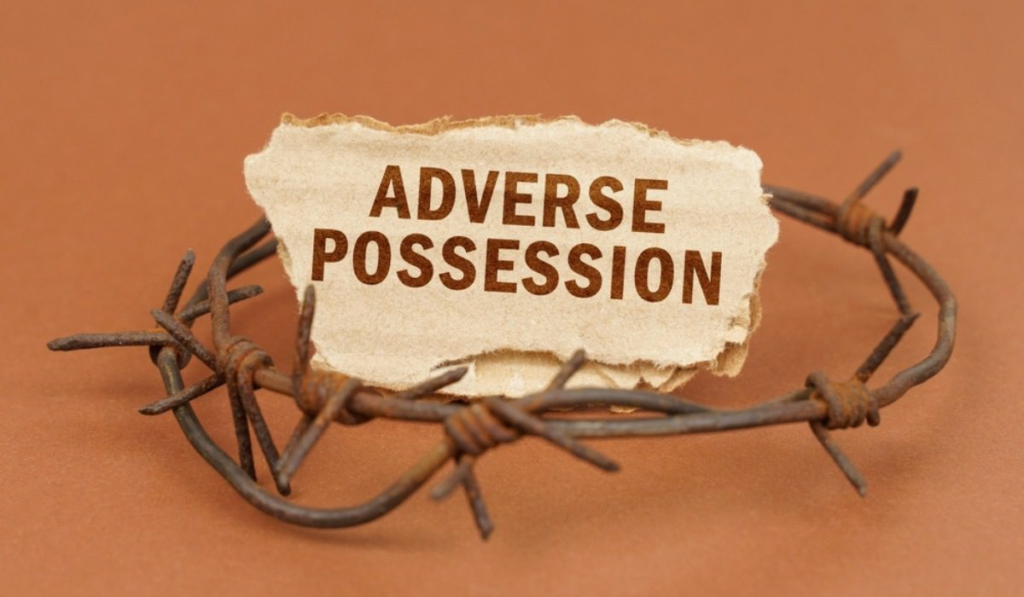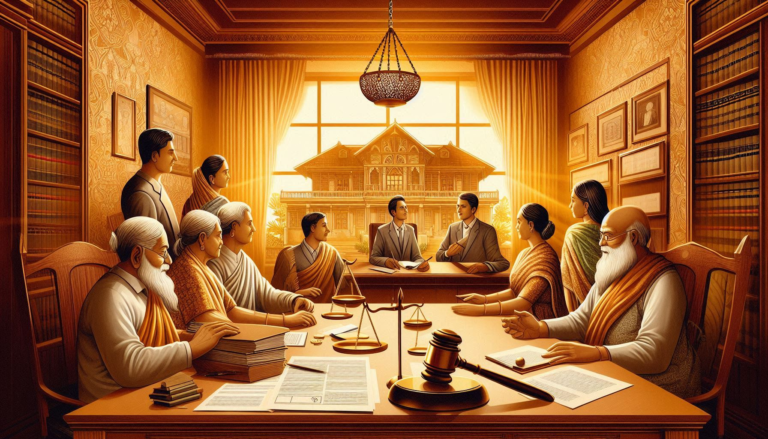
INTRODUCTION:THE PARADOX AT THE HEART OF PROPERTY LAW
To speak of Adverse Possession is to speak of one of the most intellectually vexing and morally ambiguous doctrines in the Indian legal landscape. It is a concept that seems to turn the very notion of property ownership on its head, allowing a trespasser—a squatter—to legally acquire the title to a piece of land merely by occupying it for a stipulated, uninterrupted period. This is not simply a rule of law; it is a profound philosophical statement on the nature of right, diligence, and the social function of land.
The provision, codified primarily within the Limitation Act, 1963, sets out two distinct timeframes for claiming ownership: 12 years for privately owned land and 30 years for government property. This differential period reflects an understandable policy position that the State, with its vast holdings and bureaucratic complexity, requires a longer window of protection. The current 30-year period for government land is itself an improvement, a reduction from the onerous 60 years previously mandated by the Limitation Act of 1908.
Despite the inherent unfairness it appears to sanction—the rewarding of a wrongdoer at the expense of a negligent but rightful owner—Adverse Possession is far from an Indian anomaly. It is a resilient legal principle, an artifact of ancient jurisprudence that persists across numerous jurisdictions worldwide. Yet, its persistence has not shielded it from relentless criticism, leading to the Supreme Court itself, in the case of Hemaji Waghaji Jathas v. Rohan1, to unequivocally label the concept as “immoral.”
The following critique delves into this legal paradox, exploring its historical roots, dissecting the foundational arguments for and against its retention, analyzing the crucial judicial affirmation in Ravinder Kaur Grewal v. Manjit Kaur2, and offering constructive suggestions for reform to align this archaic doctrine with contemporary notions of justice and fairness.
THE HISTORICAL ROOTS AND ESSENTIAL INGREDIENTS OF A HOSTILE CLAIM
A Journey Through Time: The Doctrine’s Genesis
The concept of Adverse Possession is not a modern invention; its lineage can be traced back to Roman law, where the Doctrine of Usucapio (acquisition by use) allowed a person to gain title to property after a period of peaceful and uninterrupted possession. The rationale then, as now, was twofold: to prevent stale claims and to reward the productive use of land. The common law, from which the Indian legal system heavily borrows, refined this into a rule that, primarily, barred the true owner’s remedy to recover possession, effectively extinguishing their title and vesting it in the adverse possessor. It is a creature of limitation, an operation of law that cuts off a right due to the owner’s prolonged and inexcusable inaction.
The Quintessential Elements: Nec Vi, Nec Clam, Nec Precario
For a claim of adverse possession to succeed, it must be demonstrably built on a foundation of specific, essential ingredients. These are often summarized by the Latin maxim: Nec Vi, Nec Clam, Nec Precario—meaning without force, without secrecy, and without permission.
- Hostile Possession (Hostility): The possession must be truly adverse and hostile to the true owner’s interest. The squatter is not there by license, lease, or any agreement. They must clearly assert a right against the owner.
- Actual Possession (Factum): The claimant must be in actual, physical, and exclusive control of the property. This means occupying, cultivating, enclosing, or otherwise treating the land as an owner would.
- Open and Conspicuous Possession (Clam): The occupation must be so overt, public, and notorious that the true owner is presumed to have knowledge of it. The Law Commission’s emphasis, referencing Larissa Katz’s work3, underscores this crucial point: the possession cannot be clandestine. It must be so conspicuous that it essentially issues a challenge to the true owner, forcing them to act or forfeit their right.
- Continuous Possession (Tempus): The occupation must be uninterrupted for the full statutory period (12 or 30 years). Any acknowledgment of the true owner’s title or a successful dispossession by the true owner resets the clock.
In essence, the law does not reward a furtive thief; it rewards a bold, productive, and visible usurper whom the true owner has, through their own passivity, implicitly sanctioned over time.
ARGUMENTS IN DEFENCE OF AN IMMORAL RIGHT: THE SOCIAL WELFARE RATIONALE
Despite the moral outcry, the doctrine of Adverse Possession is not without its thoughtful defenders. Its retention, even in jurisdictions that have considered its abolition, hinges on several powerful, utilitarian, and social welfare arguments.
Punishing the Dormant Owner and Rewarding Productivity
The primary rationale is one of societal efficiency and public policy: land must be put to use. The law abhors a vacuum. If a true owner possesses a title but remains in absentia for decades, allowing the land to lie fallow or be appropriated by another, the law steps in to transfer the title to the party who is actively contributing to its utility. This function punishes the dormant owner—the one who sleeps on their rights (Vigilantibus Non Dormientibus Aequitas Subvenit). It incentivizes the true owner to be a vigilant steward of their property.
The Quieting of Titles and Preventing Stale Claims
Adverse Possession serves as crucial to public interest in quieting titles. After a long period of factual possession, the documentary chain of title may become obscure, witnesses may pass away, and evidence may be lost. If the person in long-term possession, who has treated the land as their own and possibly made improvements, could be dispossessed at any time, economic activity and investment would be chilled. The doctrine offers a statute of repose, drawing a definitive line in the sand beyond which ancient, uncertain claims cannot be resurrected, thereby ensuring certainty and finality in property rights.
The Social Welfare and De Facto Right of the Possessor
As noted in the critique, Larissa Katz’s perspective highlights the philosophical depth: Adverse Possession can be seen as a right conferred from a social welfare perspective. Often, adverse possessors are the marginalized or poor, who, out of sheer necessity, have settled on unused land and built a life there. Their long, visible occupation creates a de facto social right that the law eventually recognizes as a de jure title. Removing this right arbitrarily, as the Law Commission of India noted in its 2023 report, could indeed “lead to widespread chaos and confusion” by displacing settled communities and destabilizing long-established local economies.

THE SUPREME COURT’S AFFIRMATION AND THE RAVINDER KAUR DOCTRINE
The Power to Use Adverse Possession as a Sword
A key point of contention and confusion in Indian jurisprudence was whether Adverse Possession could only be used as a ‘shield’—a defence against the true owner’s suit for recovery—or also as a ‘sword’—a basis for the adverse possessor themselves to file a suit to establish their title.
In the landmark 2019 judgment of Ravinder Kaur Grewal v. Manjit Kaur4, a three-judge Bench of the Supreme Court provided a definitive answer. Overruling several contrary past decisions, the Court unequivocally affirmed that once a person has perfected their title through the statutory period of adverse possession, that title is as robust as any derived from a registered deed. Consequently, the Court held that the adverse possessor can use this newly acquired title not just defensively, but offensively, meaning “even a suit can be filed to claim title on the basis of adverse possession”.
This judgment has vast practical implications. It solidifies the status of the adverse possessor from a mere trespasser protected by a limitation period to a full owner with all the legal rights that ownership entails, thereby adding a layer of finality to the doctrine.
The Moral Tension: Hemaji Waghaji Jathas
However, the moral shadow cast over the doctrine remains deep. The Supreme Court’s own internal struggle is perhaps best illustrated by the 2011 observation in Hemaji Waghaji Jathas5, where the Court called the concept “immoral” and urged the Government of India to consider its complete overhaul or even abolition. This highlights the uncomfortable truth: Adverse Possession, while legally essential for finality, is ethically challenging, as it rewards a wrongdoing that initially constituted a tort (trespass).
A DEEP DIVE INTO THE CRITIQUE: THE UNFAIRNESS TO THE TRUE OWNER
The essence of the critique lies in the doctrine’s unfair, and some would argue, unconstitutional impact on the true owner’s fundamental right to property.
The Principle of Fairness and the Sweat of the Brow
The fundamental principle governing the acquisition of property, whether tangible or intellectual, is that an individual must be rewarded for their labour and investment. This is the “sweat of the brow” theory, which is central to granting ownership in copyrights and patents.
The true owner has invested their money (the capital cost of acquisition), their labour (the effort of finding, registering, and managing the property), and their future security in the property. To have this hard-earned right extinguished merely by another’s uninterrupted occupation, regardless of the true owner’s negligence, feels arbitrary and violative of the very principle of fairness. The adverse possessor, by contrast, merely occupies, sometimes with no investment, ultimately gaining a windfall at the expense of another’s legitimate effort.
The Modern Context: Non-Use and Negligence vs. Trespass
In a globalized, mobile, and complex economy, the true owner’s “negligence” may not be a sign of deliberate abandonment. An owner may be:
- Serving abroad for a multinational company or the military.
- Incarcerated, sick, or legally disabled.
- A member of the diaspora, retaining the property as an asset for their return.
In all these scenarios, the owner has a legitimate, defensible reason for non-use, yet the law of adverse possession treats their inaction as an abandonment, thereby favouring the trespasser. It forces a constant, vigilant monitoring of property, a burden that is often difficult to meet, especially for owners of non-contiguous or distant plots.
SUGGESTIONS FOR REFORM: ALIGNING LAW WITH JUSTICE
Given the doctrine’s dual nature—being a necessary evil for certainty but a moral outrage for fairness—the path forward lies not in outright abolition (which the Law Commission was cautious about) but in significant, principled reform.
Extension of the Minimum Duration of Occupation
The current 12-year period for private land, while common in its historical context, appears unduly short in the modern world. It is the core reason for the injustice felt by true owners. As a critical suggestion, the minimum duration of occupation should be extended.
Comparative Law Precedents: The critique rightly points to leading jurisdictions that have adopted far longer periods. Spain, France, and Germany establish a requirement of a continuous occupation of at least 30 years to claim ownership rights for privately owned property. This extended period dramatically raises the burden on the adverse possessor and provides a much fairer margin of error and time for the true owner to discover and reassert their rights.
Recommendation: Raising the Indian limit for private land from 12 to 20 or even 30 years would strike a better balance between the need for finality and the protection of proprietary rights. The length of time itself would serve as a stricter filter, ensuring only those possessors with the most enduring and established social claim succeed.
Introducing a ‘Good Faith’ Element
Current Indian law does not require the adverse possessor to be in “good faith.” The possessor can be fully aware they are trespassing and still acquire title. Reform Suggestion: The law should consider introducing a modified requirement that the adverse possessor must have a bona fide (good faith) belief that the land was theirs, or that the land was effectively abandoned. This would distinguish a genuine mistake from a deliberate, opportunistic act of encroachment and bring the law closer to principles of equity.

A Special Category for Vulnerable Owners
The law should create exceptions for vulnerable owners whose inability to monitor their property is legally excusable.
Recommendation: Owners who are mentally or physically disabled, serving in the armed forces, or Non-Resident Indians (NRIs) should be afforded an extended limitation period—a “super-limitation period”—beyond the standard requirement, similar to the extra protection currently granted to the government. This policy would recognize that not all inaction is the result of negligence.
CONCLUSION: THE FINAL RECKONING OF RIGHT AND JUSTICE
Adverse Possession remains a crucible in which property law, social policy, and ethical considerations are forged. It is a doctrine that forces us to answer a difficult question: When does a documented legal right yield to a lived social reality?
While the social welfare arguments—the need to quiet titles, reward productivity, and stabilize long-term occupancy—provide compelling reasons for the continuance of the right, the inherent unfairness to the original owner, who has invested their capital and labour, cannot be ignored. The Supreme Court’s declaration in Hemaji Waghaji Jathas that the concept is “immoral” is a powerful and necessary judicial conscience check.
The Ravinder Kaur Grewal judgment has solidified the status of the adverse possessor as a true owner once the period is complete, transforming the ‘shield’ into a potent ‘sword’. This affirmation of the doctrine’s strength makes the need for reform even more critical.
The most pragmatic path forward, as suggested, is to retain the doctrine for its essential function of legal certainty but to fundamentally alter the quantum of negligence required of the true owner. By extending the limitation period to align with jurisdictions like Spain and Germany, introducing a consideration for good faith, and creating exceptions for vulnerable owners, the Indian legal system can move towards a more just and equitable balance. Only then can Adverse Possession transition from being a critique of unfairness to a constructive example of a legal mechanism that harmonises proprietary rights with social utility.
Footnotes
- Hemaji Waghaji Jat v. Bhikhabhai Khengarbhai Harijan, (2009) 16 SCC 517 (India) (decided Sept. 23, 2008). ↩︎
- Ravinder Kaur Grewal v. Manjit Kaur, (2019) 8 SCC 729 (India) (decided Aug. 7, 2019). ↩︎
- Larissa M. Katz, The Moral Paradox of Adverse Possession: Sovereignty and Revolution in Property Law, 55 McGill L.J. 47 (2010). ↩︎
- Ibid. ↩︎
- Ibid. ↩︎




